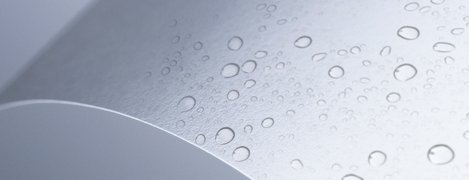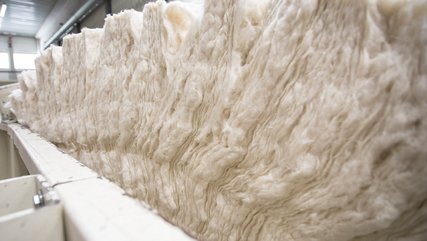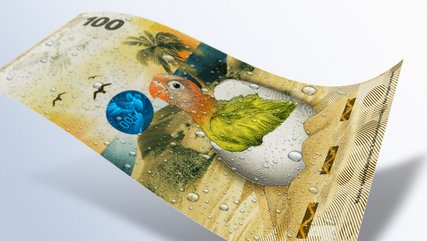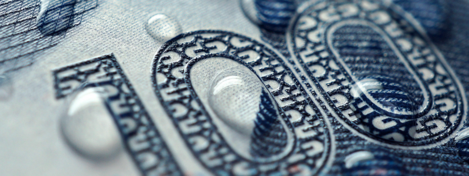

Persistent and resistant
A common trend in the market for banknote substrates is to maximize the durability of the notes and their security features – but without compromising sustainability. In order to achieve this goal while avoiding the excessive use of plastics, the state of the art today is high-tech, hybrid banknote paper. In this article, we take a look through the history of substrate development and show what’s available today.
Defining durability
Let’s start with a few definitions. With durability, central banks want their notes to comply with their clean note policy and continue to look good. The notes also need to stand up to machine processing for as long as possible. But banks also need to ensure that the embedded security functionality continues to work flawlessly and remain attractive throughout the note’s lifecycle. The protection is clearly essential, but so is cost optimization. It can be expensive to replace an entire series of notes, so it makes sense to keep them in circulation for a long time. This is especially true in countries that don’t yet use much machine processing in their cash cycle, as the notes are handled manually much more.

Moving to sustainability, there’s clearly been a lot more focus recently on the damage that (micro)plastics are inflicting on our natural environments. Many regions, including the European Union, are working on directives to oblige companies to limit their use of (micro)plastics. This influences banknote substrate manufacture too, especially the use of polymer-based films and coatings. A further sustainability aspect, however, is the core material of the substrate. “At Louisenthal, we use waste from the textile industry – short-fibre cotton that can’t be used for clothing or furnishings and would otherwise be discarded,” explains Astrid Drexler, Product Manager at Louisenthal. “This is sustainability at its best – what’s waste for another industry is a valuable raw material for us,” she adds. The company is committed to maximizing sustainability: its strategy is to use as little plastic and as much cotton as possible to ensure strength and a long lifespan for its banknote substrates.
Security – a top priority
A banknote’s security features help people verify its authenticity while contributing to its overall aesthetic appeal. At Louisenthal, we embed them right into the underlying substrate so that they’re inextricably bound up with the fibres. This makes them extremely difficult to counterfeit. One way Louisenthal stands out from other substrate providers, however, is that it also actively develops new innovations to ensure the security features are durable too – not just the substrate. We’ll come back to this aspect in a moment.
Hybrid has been further developed recently, resulting in an equally smart innovation: Hybrid ADDvance.
Astrid Drexler, Product Manager at Louisenthal


How substrate trends have evolved
“For centuries, natural fibres – primarily cotton – were the only raw materials used for banknote paper around the world,” says Astrid Drexler. Even as late as the 1950s, only very few were durable, although they comprised additional materials such as flax and rag pulp. By the mid-1950s, some banks experimented with varnishing them. From the 1960s onwards, various companies tried to develop longer-lasting alternative substrates, essentially based on plastic. The mid-70s saw new banknotes, initially in the Netherlands (the Dutch guilder), made of synthetic fibres combined with the cotton raw material.
Australia was the first country to issue 100% plastic banknotes, with the A$10 note the first denomination to appear in 1988. Today, all Australia’s notes are polymer-based. “However, polymer can raise sustainability and ecological questions,” notes Astrid Drexler. “That’s why the focus has increasingly been on developing a tough substrate that would retain the feel and other benefits of traditional cotton-based paper, while lasting for much longer. This is the approach we’re taking at Louisenthal.”
The first banknotes featuring protective coatings entered circulation at the end of the 1990s. Louisenthal recognized this potential and started to develop a completely new banknote substrate that would combine the benefits of cotton and polymer. In 2008, Louisenthal launched its pioneering substrate: the Hybrid™. “This substrate is particularly robust and resistant to tearing and soiling, so it’s ideal for small denominations that change hands frequently,” explains Astrid Drexler. “Hybrid combines the advantages of paper and polymer banknotes by applying a protective polyester film to a cotton fibre core. This ensures substrate and security features stay functional throughout the note’s lifetime.” These attributes also make it ideal for lower and medium denominations as well as harsh circulation conditions like tropical climates.
Astrid Drexler adds: “Hybrid has been further developed recently, resulting in an equally smart innovation: Hybrid ADDvance®. This differs from Hybrid in that it allows customers to secure their whole series from low to high denominations with the addition of advanced security features like patches and windows, in addition to pre-existing, paper-based elements such as watermarks.”
Other companies in the market have innovated too. One example is the Swiss banknote series, which is based on an interesting concept that has cotton on the outside and polymer as its core. The Swiss National Bank has been gradually changing its entire banknote series to this new substrate since April 2016.

Machine processing: a further factor in banknote durability
Today, many industrialized countries make widespread use of machine processing in their cash cycle. Worldwide, the implementation of high-tech, automated handling and sorting systems has increased significantly. Highly resilient substrates like Hybrid and ADDvance are ideal for countries making little or no use of machine processing. However, they are also useful in markets with machine processing, where mechanical stability is a prerequisite to ensure that the banknotes can stand up to efficient machine processing for a long time.
Security features also need to be durable
As we saw earlier, it’s not just about the substrate – the banknote’s security features must also resist soiling, scratching and other damage until the end of the note’s lifecycle. This is essential to enable users to clearly verify a note’s authenticity – across all denominations, not just the highest ones. With Hybrid ADDvance, foil-based security features like patches, stripes and windows are 100% protected by a thin film layer. This ensures public and machine authentication on all security levels until the end of a note’s lifespan.
Usage defines substrate choice
The banknote market offers a wide choice of substrate solutions that meet the varying usage requirements defined by central banks for their specific country’s needs. The substrate choice will depend on the denomination of each note as well as on climate-related and cultural factors. It’s essential to get the technical specifications right before starting the design process.
Louisenthal has decades of experience in every detail of substrate planning, design and manufacture, and its expert teams are available for consulting on these issues. As one of the world’s leading suppliers, we know that the right choice of substrate is a key criterion in optimizing the cash cycle.
Louisenthal’s substrate portfolio

- Hybrid ADDvance®: based on the proven Hybrid technology; high durability throughout all denominations; security features can be scaled up for higher-value notes; consistent cotton-like touch and feel
- Hybrid™: ideal for tropical countries and other difficult circulation conditions; high durability especially for lower denominations; consistent cotton-like touch and feel
- LongLife™: substrate with extra coating to resist soiling
- Cotton Standard: proven cotton substrate; supports integration of multiple printed, embedded and applied security features

Further Reading
Banknote paper
Louisenthal offers a range of substrates for different currency requirements, security levels, circulation conditions and denominations. And if you’re planning a completely new banknote series, we can advise you on a mix of different substrate types and features across the series.
Security paper
Passports, certificates and valuable tickets must be counterfeit- and manipulation-proof, durable and suitable for a wide range of creative design options. Louisenthal ticks all these boxes with its security paper that includes cylinder mould watermarks and state of the art security features.